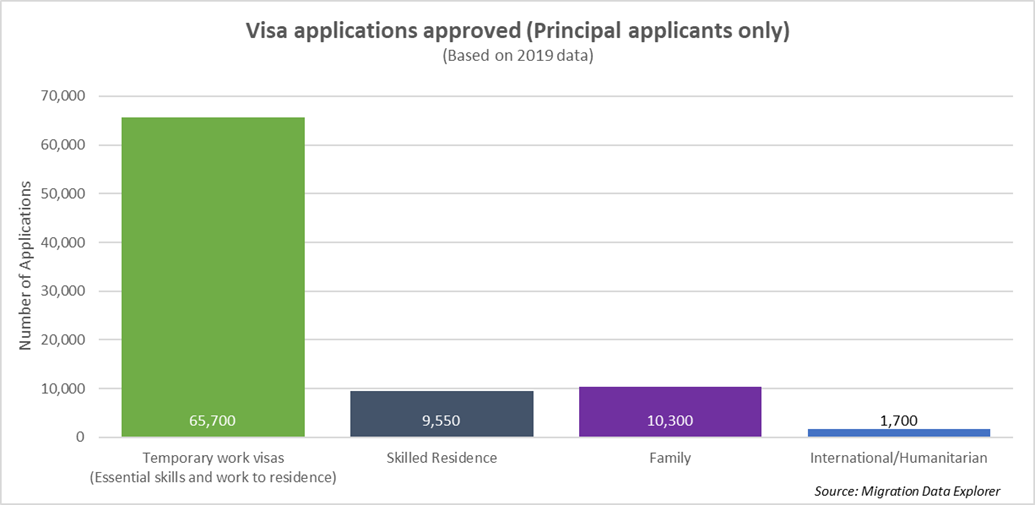Context for the Skilled Migrant Category consultation
The Government is rebalancing the immigration system to support its plan for a higher-productivity, higher-wage economy.
On this page
Immigration Rebalance
The Immigration Rebalance has been designed to make it easier to attract and hire high-skilled migrants, while supporting some sectors to transition to more productive and resilient ways of operating, instead of relying on lower-skilled migrant workers.
It aims to make it easier to fill genuine skills gaps, where New Zealanders can’t be found. For highly skilled workers in global shortage, it will ensure New Zealand is an attractive destination, with priority pathways to residence and simplified application processes.
Together these changes aim to:
- encourage employers to offer competitive wages, hire less-experienced New Zealanders and train them, and work together as a sector to showcase employment opportunities and career pathways. This will help build businesses’ resilience and productivity.
- encourage businesses to invest more. Technology provides huge opportunities to increase productivity and create more value, and these upfront investments will pay dividends in the long run.
- reduce the recent pressure on infrastructure and housing and support economic growth. Our GDP growth in the past has been led by high levels of migration, but the GDP growth per capita has been much lower. By shifting to a higher skill mix of migrant labour and reducing the previous reliance on low wage low skill migrant labour, this can help New Zealand grow a more productive economy.
Immigration Rebalance [PDF 365 KB](external link) — beehive.govt.nz
New Residence Visas
New priority skilled residence pathways have been introduced under the Immigration Rebalance. These are expected to cover up to 45 to 55% of the people previously approved under the Skilled Migrant Category and will mean that there are 3 main pathways to skilled residence:
- the Skilled Migrant Category, which recognises individuals’ skills
- the Green List residence pathways for eligible migrants in specified highly skilled, hard-to-fill occupations
- the Highly Paid Residence Visa for migrants earning at least twice median wage.
More information on these new pathways:
- Green List residence pathways(external link) — Immigration New Zealand
- Highly Paid Residence Visa(external link) — Immigration New Zealand
2021 Resident Visa
106,048 applications have been received covering 214,428 people (principal applications and their partners/families) for the the one-off 2021 Resident Visa. This is equivalent to more than five years of all residence approvals pre-COVID. It includes both people who would have become eligible for the Skilled Migrant Category over the next few years and people who would otherwise not have been eligible for residence. The key criteria for the visa were that people were in New Zealand on eligible visas on 29 September 2021 and either:
- 'settled': have lived in New Zealand for the past three or more years, or
- 'skilled': earn at or above the median wage (NZD $27 per hour), or
- ‘scarce’: work in a role on a scarce list.
2021 Resident Visa(external link) — Immigration New Zealand
What does residence give you?
The two main visa classes in the New Zealand immigration system are temporary entry and residence class visas:
- A temporary entry class visa allows a holder to be in New Zealand for the purpose and length of the visa (e.g. for work, study, or holiday/visit). Following recent changes under the Immigration Rebalance, the main skilled temporary work visa is the Accredited Employer Work Visa (AEWV), which allows employers to hire migrants on visas for up to three years. Employers must pay market rate and at least the median wage, with limited exceptions, and show that they cannot find a suitable New Zealander for the job first.
- A residence class visa provides the holder the right to live and work in New Zealand indefinitely, as well as the rights to vote, buy a house, and access social security benefits and subsidised tertiary education. There are three overarching residence streams: Skilled Residence (which is the subject of this consultation), Family, and International/Humanitarian (including refugees).
Accredited Employer Work Visa (AEWV)(external link) — Immigration New Zealand
The figure below shows a comparison of the number of temporary work visa and residence visa approvals in 2019. The number of temporary work visas includes both new migrants and those renewing visas or changing visa types.

2019 Comparison of temporary and residence visa approvals.
Read the data for the graph

